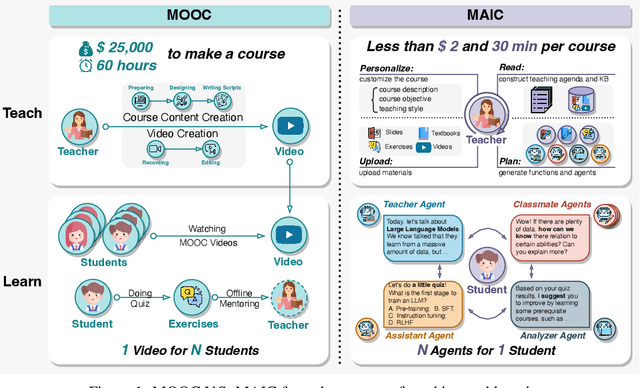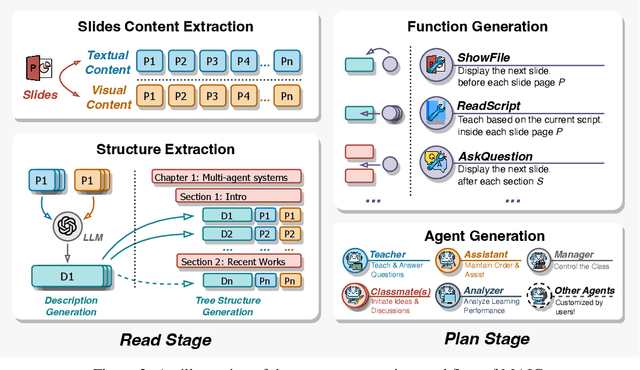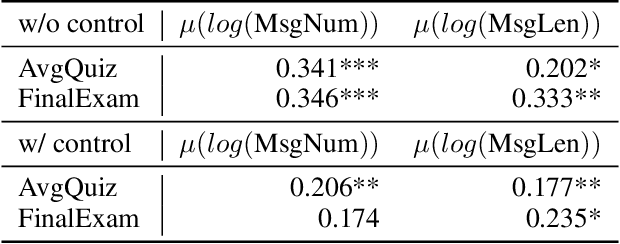Shangqing Tu
Shifting Long-Context LLMs Research from Input to Output
Mar 07, 2025Abstract:Recent advancements in long-context Large Language Models (LLMs) have primarily concentrated on processing extended input contexts, resulting in significant strides in long-context comprehension. However, the equally critical aspect of generating long-form outputs has received comparatively less attention. This paper advocates for a paradigm shift in NLP research toward addressing the challenges of long-output generation. Tasks such as novel writing, long-term planning, and complex reasoning require models to understand extensive contexts and produce coherent, contextually rich, and logically consistent extended text. These demands highlight a critical gap in current LLM capabilities. We underscore the importance of this under-explored domain and call for focused efforts to develop foundational LLMs tailored for generating high-quality, long-form outputs, which hold immense potential for real-world applications.
LongWriter-V: Enabling Ultra-Long and High-Fidelity Generation in Vision-Language Models
Feb 20, 2025Abstract:Existing Large Vision-Language Models (LVLMs) can process inputs with context lengths up to 128k visual and text tokens, yet they struggle to generate coherent outputs beyond 1,000 words. We find that the primary limitation is the absence of long output examples during supervised fine-tuning (SFT). To tackle this issue, we introduce LongWriter-V-22k, a SFT dataset comprising 22,158 examples, each with multiple input images, an instruction, and corresponding outputs ranging from 0 to 10,000 words. Moreover, to achieve long outputs that maintain high-fidelity to the input images, we employ Direct Preference Optimization (DPO) to the SFT model. Given the high cost of collecting human feedback for lengthy outputs (e.g., 3,000 words), we propose IterDPO, which breaks long outputs into segments and uses iterative corrections to form preference pairs with the original outputs. Additionally, we develop MMLongBench-Write, a benchmark featuring six tasks to evaluate the long-generation capabilities of VLMs. Our 7B parameter model, trained with LongWriter-V-22k and IterDPO, achieves impressive performance on this benchmark, outperforming larger proprietary models like GPT-4o. Code and data: https://github.com/THU-KEG/LongWriter-V
LongBench v2: Towards Deeper Understanding and Reasoning on Realistic Long-context Multitasks
Dec 19, 2024



Abstract:This paper introduces LongBench v2, a benchmark designed to assess the ability of LLMs to handle long-context problems requiring deep understanding and reasoning across real-world multitasks. LongBench v2 consists of 503 challenging multiple-choice questions, with contexts ranging from 8k to 2M words, across six major task categories: single-document QA, multi-document QA, long in-context learning, long-dialogue history understanding, code repository understanding, and long structured data understanding. To ensure the breadth and the practicality, we collect data from nearly 100 highly educated individuals with diverse professional backgrounds. We employ both automated and manual review processes to maintain high quality and difficulty, resulting in human experts achieving only 53.7% accuracy under a 15-minute time constraint. Our evaluation reveals that the best-performing model, when directly answers the questions, achieves only 50.1% accuracy. In contrast, the o1-preview model, which includes longer reasoning, achieves 57.7%, surpassing the human baseline by 4%. These results highlight the importance of enhanced reasoning ability and scaling inference-time compute to tackle the long-context challenges in LongBench v2. The project is available at https://longbench2.github.io.
Awaking the Slides: A Tuning-free and Knowledge-regulated AI Tutoring System via Language Model Coordination
Sep 11, 2024Abstract:The vast pre-existing slides serve as rich and important materials to carry lecture knowledge. However, effectively leveraging lecture slides to serve students is difficult due to the multi-modal nature of slide content and the heterogeneous teaching actions. We study the problem of discovering effective designs that convert a slide into an interactive lecture. We develop Slide2Lecture, a tuning-free and knowledge-regulated intelligent tutoring system that can (1) effectively convert an input lecture slide into a structured teaching agenda consisting of a set of heterogeneous teaching actions; (2) create and manage an interactive lecture that generates responsive interactions catering to student learning demands while regulating the interactions to follow teaching actions. Slide2Lecture contains a complete pipeline for learners to obtain an interactive classroom experience to learn the slide. For teachers and developers, Slide2Lecture enables customization to cater to personalized demands. The evaluation rated by annotators and students shows that Slide2Lecture is effective in outperforming the remaining implementation. Slide2Lecture's online deployment has made more than 200K interaction with students in the 3K lecture sessions. We open source Slide2Lecture's implementation in https://anonymous.4open.science/r/slide2lecture-4210/.
From MOOC to MAIC: Reshaping Online Teaching and Learning through LLM-driven Agents
Sep 05, 2024



Abstract:Since the first instances of online education, where courses were uploaded to accessible and shared online platforms, this form of scaling the dissemination of human knowledge to reach a broader audience has sparked extensive discussion and widespread adoption. Recognizing that personalized learning still holds significant potential for improvement, new AI technologies have been continuously integrated into this learning format, resulting in a variety of educational AI applications such as educational recommendation and intelligent tutoring. The emergence of intelligence in large language models (LLMs) has allowed for these educational enhancements to be built upon a unified foundational model, enabling deeper integration. In this context, we propose MAIC (Massive AI-empowered Course), a new form of online education that leverages LLM-driven multi-agent systems to construct an AI-augmented classroom, balancing scalability with adaptivity. Beyond exploring the conceptual framework and technical innovations, we conduct preliminary experiments at Tsinghua University, one of China's leading universities. Drawing from over 100,000 learning records of more than 500 students, we obtain a series of valuable observations and initial analyses. This project will continue to evolve, ultimately aiming to establish a comprehensive open platform that supports and unifies research, technology, and applications in exploring the possibilities of online education in the era of large model AI. We envision this platform as a collaborative hub, bringing together educators, researchers, and innovators to collectively explore the future of AI-driven online education.
R-Eval: A Unified Toolkit for Evaluating Domain Knowledge of Retrieval Augmented Large Language Models
Jun 17, 2024Abstract:Large language models have achieved remarkable success on general NLP tasks, but they may fall short for domain-specific problems. Recently, various Retrieval-Augmented Large Language Models (RALLMs) are proposed to address this shortcoming. However, existing evaluation tools only provide a few baselines and evaluate them on various domains without mining the depth of domain knowledge. In this paper, we address the challenges of evaluating RALLMs by introducing the R-Eval toolkit, a Python toolkit designed to streamline the evaluation of different RAG workflows in conjunction with LLMs. Our toolkit, which supports popular built-in RAG workflows and allows for the incorporation of customized testing data on the specific domain, is designed to be user-friendly, modular, and extensible. We conduct an evaluation of 21 RALLMs across three task levels and two representative domains, revealing significant variations in the effectiveness of RALLMs across different tasks and domains. Our analysis emphasizes the importance of considering both task and domain requirements when choosing a RAG workflow and LLM combination. We are committed to continuously maintaining our platform at https://github.com/THU-KEG/R-Eval to facilitate both the industry and the researchers.
Knowledge-to-Jailbreak: One Knowledge Point Worth One Attack
Jun 17, 2024



Abstract:Large language models (LLMs) have been increasingly applied to various domains, which triggers increasing concerns about LLMs' safety on specialized domains, e.g. medicine. However, testing the domain-specific safety of LLMs is challenging due to the lack of domain knowledge-driven attacks in existing benchmarks. To bridge this gap, we propose a new task, knowledge-to-jailbreak, which aims to generate jailbreaks from domain knowledge to evaluate the safety of LLMs when applied to those domains. We collect a large-scale dataset with 12,974 knowledge-jailbreak pairs and fine-tune a large language model as jailbreak-generator, to produce domain knowledge-specific jailbreaks. Experiments on 13 domains and 8 target LLMs demonstrate the effectiveness of jailbreak-generator in generating jailbreaks that are both relevant to the given knowledge and harmful to the target LLMs. We also apply our method to an out-of-domain knowledge base, showing that jailbreak-generator can generate jailbreaks that are comparable in harmfulness to those crafted by human experts. Data and code: https://github.com/THU-KEG/Knowledge-to-Jailbreak/.
DICE: Detecting In-distribution Contamination in LLM's Fine-tuning Phase for Math Reasoning
Jun 06, 2024Abstract:The advancement of large language models (LLMs) relies on evaluation using public benchmarks, but data contamination can lead to overestimated performance. Previous researches focus on detecting contamination by determining whether the model has seen the exact same data during training. In this work, we argue that even training on data similar to benchmark data inflates performance on in-distribution tasks without improving overall capacity, which we called In-distribution contamination. To effectively detect in-distribution contamination, we propose DICE, a novel method that leverages the internal states of LLMs to locate-then-detect the contamination. DICE first identifies the most sensitive layer to contamination, then trains a classifier based on the internal states of that layer. Experiments reveal DICE's high accuracy in detecting in-distribution contamination across various LLMs and math reasoning datasets. We also show the generalization capability of the trained DICE detector, which is able to detect contamination across multiple benchmarks with similar distributions. Additionally, we find that the DICE detection scores are positively correlated with the performance of ten LLMs fine-tuned by either us or other organizations on four math reasoning datasets (with $R^2$ values between 0.6 and 0.75). This indicates that the in-distribution contamination problem potentially lead to an overestimation of the true capabilities of many existing models. The code and data are available at https://github.com/THU-KEG/DICE.
A Solution-based LLM API-using Methodology for Academic Information Seeking
May 24, 2024Abstract:Applying large language models (LLMs) for academic API usage shows promise in reducing researchers' academic information seeking efforts. However, current LLM API-using methods struggle with complex API coupling commonly encountered in academic queries. To address this, we introduce SoAy, a solution-based LLM API-using methodology for academic information seeking. It uses code with a solution as the reasoning method, where a solution is a pre-constructed API calling sequence. The addition of the solution reduces the difficulty for the model to understand the complex relationships between APIs. Code improves the efficiency of reasoning. To evaluate SoAy, we introduce SoAyBench, an evaluation benchmark accompanied by SoAyEval, built upon a cloned environment of APIs from AMiner. Experimental results demonstrate a 34.58-75.99\% performance improvement compared to state-of-the-art LLM API-based baselines. All datasets, codes, tuned models, and deployed online services are publicly accessible at https://github.com/RUCKBReasoning/SoAy.
WaterBench: Towards Holistic Evaluation of Watermarks for Large Language Models
Nov 13, 2023Abstract:To mitigate the potential misuse of large language models (LLMs), recent research has developed watermarking algorithms, which restrict the generation process to leave an invisible trace for watermark detection. Due to the two-stage nature of the task, most studies evaluate the generation and detection separately, thereby presenting a challenge in unbiased, thorough, and applicable evaluations. In this paper, we introduce WaterBench, the first comprehensive benchmark for LLM watermarks, in which we design three crucial factors: (1) For \textbf{benchmarking procedure}, to ensure an apples-to-apples comparison, we first adjust each watermarking method's hyper-parameter to reach the same watermarking strength, then jointly evaluate their generation and detection performance. (2) For \textbf{task selection}, we diversify the input and output length to form a five-category taxonomy, covering $9$ tasks. (3) For \textbf{evaluation metric}, we adopt the GPT4-Judge for automatically evaluating the decline of instruction-following abilities after watermarking. We evaluate $4$ open-source watermarks on $2$ LLMs under $2$ watermarking strengths and observe the common struggles for current methods on maintaining the generation quality. The code and data are available at \url{https://github.com/THU-KEG/WaterBench}.
 Add to Chrome
Add to Chrome Add to Firefox
Add to Firefox Add to Edge
Add to Edge